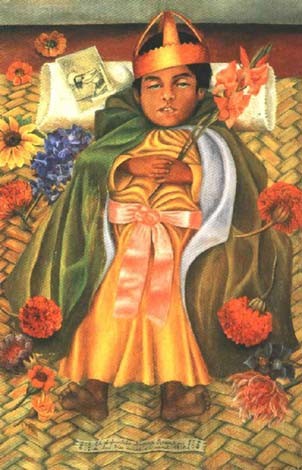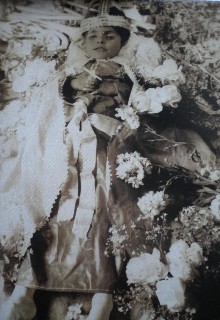The Deceased Dimas
1937
In the early years of Frida's painting career she would occasionally paint portraits of children. In Mexico it is a tradition to memorialize a dead child through a painting, a tradition dating back to 16th century colonial times.
The deceased subject of this painting is the three year old child of Delfina, an Indian woman from Ixtapalapa who often sat for Diego as a model. When the child was baptized, Rivera was chosen as the godfather. The child became seriously ill and the family insisted that the child be treated ONLY by witch doctors rather than medical doctors. Despite all of Diego's efforts to get the child treated by a medical doctor the family resisted and eventually the child died. The inscription at the bottom of the painting reads: "The Deceased Dimas Rosas at 3 Years Old - 1937".
The deceased child is dressed in honor of Saint Joseph, the patron saint of New Spain and is surrounded by flowers, one of which is the Cempasúchil (marigold) flower typical of the "Day of the Dead" festival in Mexico. A popular holy picture of Christ "The Lord of the Column" rests on his pillow.
It's unclear as to why the painting was not given to the mother of the deceased child as a remembrance. The painting was first displayed in New York in 1938 at Julien Levy's surrealism gallery under the title "Dressed Up for Paradise". It was bought by Somerset Maugham. In 1943, the painting was displayed at the Art Museum of Philadelphia under the title "The Boy King". When the owner, Maugham, learned that the painting was of a deceased child he gave the painting back to Frida. Frida then gave it to her sole Mexican collector, Eduardo Morillo Safa who later gave it to Dolores Olmedo where it now resides in the Dolores Olmedo Museum in Mexico City.

Oil
on masonite
18 ¾" x 12"
Dolores Olmedo Patiño Museum
Mexico City, Mexico
Óleo sobre masonite
48 x 31 cm.
Museo Dolores
Olmedo Patiño
Ciudad de México, México

Photo
of the Deceased Dimas
(model for the painting)
Photographer Unknown
Foto
del difuntito Dimas
(modelo para pintar)
fotógrafo desconocido
El difuntito Dimas
1937
Durante los primeros años de la carrera pictórica de Frida, a veces pintó retratos de niños. En México, es una tradición el recordar a un niño fallecido a través de un retrato, una tradición que se remonta al siglo XVI, en tiempos coloniales.
El sujeto de este cuadro es un niño fallecido de tres años de edad, el hijo de Delfina, una mujer indígena de Ixtapalapa que a menudo posaba para Diego. Cuando el niño fue bautizado, Rivera fue elegido como el padrino. . El niño se puso gravemente enfermo y la familia insistió en que el niño fuera tratado sólo por curanderos en lugar de médicos convencionales. A pesar de todos los esfuerzos de Diego para que un doctor médico tratara al niño, la familia se resistió y al final el niño murió. La inscripción en la parte inferior del cuadro reza: " El fallecido Dimas Rosas a los tres años - 1937".
El niño fallecido está vestido en honor de San José, el santo patrón de Nueva España y está rodeado de flores, una de las cuales es el Cempasúchil, una flor típica del "Día de los Muertos" de México. Una pintura sagrada popular de Cristo, "Nuestro Señor de la columna" descansa en su almohada.
No está claro por qué la pintura no se entregó como recuerdo a la madre del niño fallecido. La pintura primero se exhibió en New York en 1938, en la galería surrealista de Julián Levy, bajo el titulo "Vestido para el Paraíso". Fue comprado por Somerset Maugham. En 1943, la pintura se exhibió en el Museo de Arte de Filadelfia bajo el título "El niño rey". Cuando Maugham se enteró de que la pintura era de un niño muerto, le devolvió la pintura a Frida. Frida entonces se lo regaló a su único coleccionista Mexicano. Eduardo Morillo Safa, quien más tarde se lo obsequió a Dolores Olmedo, y ahora se muestra en el Museo Dolores Olmedo en la ciudad de México.